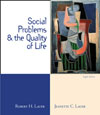 |  Social Problems and the Quality of Life, 8/e Robert H. Lauer,
U.S. International University
Jeanette C. Lauer,
U.S. International University
Education
Internet Exercises- Access the National Education Association Website. (http://www.nea.org/)
On the left side of the homepage, you will find a highlighted heading called
"Top Ten Clicks." Underneath, click on "Education Statistics."
On the Just the Stats page that results, under the heading "Rankings
of the States 2000 and Estimates of School Statistics 2001," select and
examine both "per-pupil expenditure" and "teacher salaries."
Examine the data and draw comparisons. Also on the Just the Stats page, click
on "American Education Statistics at a Glance, May 2000, updated"
and explore what's there.
- Summarize the rough correlation you find between per-pupil expenditures
and teacher salaries.
- What is the ratio of the number of elementary schools to the number of secondary
schools? How would you interpret that ratio?
- Among American K-12 students, what percentages are black? Hispanic? Native
American?
- Explore the Website of The Center for Education Reform. (http://www.edreform.com/)
On the right side of the homepage, under "Issues," select "Reform
Overview." On the new page, scroll down to the "Selected Publications
on Education Reform" section and, under that, scroll down to "Education
Manifesto: A Nation Still at Risk." Select it and read A Nation Still
at Risk: An Education Manifesto (April 30, 1998). Read the entire article,
but focus on the 10 recommendations for productive change in education.
- Summarize the ten recommendations.
- Critically evaluate the ten recommendations in terms of the ideological
position they seem to represent.
- Then, more specifically, explain why you would support any two of these
recommendations. If you find none you would support, critically evaluate
any two of the recommendations you most abhor.
|
|



 2002 McGraw-Hill Higher Education
2002 McGraw-Hill Higher Education